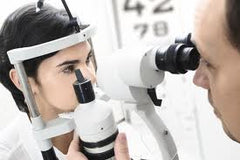LOW VISION ASSESSMENT
LOW VISION ASSESSMENT
 In a low vision assessment a practitioner will try to determine what a person with a visual impairment needs and wants to do. They will then assess the person’s visual function which may include measurement of their Visual Acuity (distance and near), Contrast Sensitivity and Functional Visual Fields. An assessment usually takes about an hour.
In a low vision assessment a practitioner will try to determine what a person with a visual impairment needs and wants to do. They will then assess the person’s visual function which may include measurement of their Visual Acuity (distance and near), Contrast Sensitivity and Functional Visual Fields. An assessment usually takes about an hour.
Using this information the practitioner will determine if any low vision aids are available to help a person with low vision do the things they want. This might include magnifiers and lights. They will also use their specialist knowledge to refer to other professionals and services which may provide additional help and support including: social services; voluntary organistions; the Hospital Eye Service for registration as Sight Impaired or Severely Sight Impaired; education services or employment services.
The appointment with the low vision practitioner is usually lasts about an hour.
The Low Vision Examination begins with an extensive history. Special emphasis is placed on the functional problems of the patient including such items as vision to read, functioning in the kitchen, glare problems, travel vision, the workplace, television viewing, school requirements, etc. It will also include a careful review of your ocular and medical history.
Preliminary test may include assessment of ocular functions such as depth perception, color vision, contrast sensitivity, curvature of the front of the eye. Careful measurements will be made of the visual acuity using low vision test charts followed by low vision refraction. Low vision test charts include a larger range of letters to more accurately determine a starting point for measurement of low vision. A low vision refraction determines the measurement of the patient’s prescription by special techniques which may include changing the lighting levels, testing through filters and using larger changes which may be easier for you to view.
If the patient has decreased acuity, the doctor may test with various telescopic systems which magnify distance vision. These may be spectacle mounted or handheld. He may also assess your response to filters to control glare. Various reading aids including strong reading eyewear, magnifiers, electronic magnifiers and even electronic reading machines may be tested.
Visual fields are usually evaluated and if the patient has a reduced visual fields, field enhancing devices may be evaluated and simple therapies to improve the patient’s use of their residual field may be prescribed.
Eye health testing may include a biomicroscopic examination of the external structures and a dilated internal examination. Glaucoma tests are performed
The doctor will counsel you on how your condition will effect your vision and what you may do to enhance and protect your vision. Independent living aids may be reviewed to fit specific patient problems.

